Resin Flow Analysis for the Foam Core Sandwich Spoiler by Vacuum-Assisted Resin Injection Process
Abstract
:1. Introduction
2. Materials and Methods
2.1. Materials and Experiments
2.2. Flow Analysis
- (1)
- At the injection port: when the constant pressure injection is applied, the injection pressure is specified as the setting value: P = P0. Especially for the vacuum injection, the injection pressure is set to atmospheric pressure, while the outlet pressure is set to 0, given that the flow was driven by vacuum pressure. When the constant velocity injection is applied, the injection velocity is also set to the setting value V = V0.
- (2)
- At the flow front, vacuum pressure is used (P = 0).
- (3)
- At the mold wall, velocities normal to the mold walls are zero and the pressure gradient is zero (∂P = ∂n = 0).
2.3. Permeability Measurement
3. Results and Discussion
3.1. Resin Flow Time
3.2. Resin Flow Front
3.3. Resin Pressure
3.4. Experimental Results
3.4.1. Analysis of the Injection Quality
3.4.2. Analysis of the Thickness
4. Conclusions
- (1)
- By simulating the resin flow process under different process schemes of spoiler structure, the resin flow situation under different combinations of resin injection schemes and RDM areas is obtained, and the time difference of the resin flow front, pressure field distribution and flow front change of upper and lower skins of the spoiler are further analyzed. The experimental results show that the simulation model established in this paper is highly accurate.
- (2)
- Two schemes of thick-end resin injection and thin-end resin injection were tested and verified, and the results showed that the resin flow time was shorter, and the internal quality of the prepared spoiler test parts was better with the thick-end resin injection scheme. In addition, the cohesive quality between the aluminum net and composite skin is better compared to the thin-end resin injection scheme.
- (3)
- For the foam sandwich structure, there is a more obvious position dependence of the thickness when the conventional VARI process is used for molding. The closer to the injection port, the thicker the product thickness is, while the thickness tends to be average at the middle of the injection and discharge port positions.
Author Contributions
Funding
Institutional Review Board Statement
Informed Consent Statement
Conflicts of Interest
References
- Jia, Z.; Li, T.; Chiang, F.P.; Wang, L. An experimental investigation of the temperature effect on the mechanics of carbon fiber reinforced polymer composites. Compos. Sci. Technol. 2018, 154, 53–63. [Google Scholar] [CrossRef]
- Zhou, Y.Q.; Pu, Y.W.; Zhan, L.H.; Song, Y.; Peng, W.F. Forming quality of composite hat-stiffened structure by autoclave co-curing process. J. Aeronaut. Mater. 2015, 35, 75–81. [Google Scholar]
- Liu, Y.N.; Yuan, C.; Liu, C.; Pan, J.; Dong, Q. Study on the resin infusion process based on automated fiber placement fabricated dry fiber preform. Sci. Rep. 2019, 9, 7440. [Google Scholar] [CrossRef] [PubMed]
- Poodts, E.; Minak, G.; Dolcini, E.; Donati, L. FE analysis and production experience of a sandwich structure component manufactured by means of vacuum assisted resin infusion process. Compos. Part B Eng. 2013, 53, 179–186. [Google Scholar] [CrossRef]
- Raounak, L.; Abdelghani, S.; Pierre, B.; Romain, A.; Bertrand, D. Numerical modeling of vacuum-assisted resin transfer molding using multilayer approach. J. Compos. Mater. 2017, 51, 3441–3452. [Google Scholar]
- Kai, J.T.; Hsiao, K.T. Improved dimensional infidelity of curve-shaped VARTM composite laminates using a multi-stage curing technique—Experiments and modeling. Compos. Part A Appl. Sci. Manuf. 2011, 42, 762–771. [Google Scholar]
- Mohan, R.V.; Shires, D.R.; Tamma, K.K.; Ngo, N.D. Flow channels/fiber impregnation studies for the process modeling/analysis of complex engineering structures manufactured by resin transfer molding. Polym. Compos. 1998, 19, 527–542. [Google Scholar] [CrossRef]
- Sales, R.; Gusmao, S.; Gouvea, R.; Chu, T.; Marlet, J.; Candido, G.; Donadon, M. The temperature effects on the fracture toughness of carbon fiber/RTM-6 laminates processed by VARTM. J. Compos. Mater. 2016, 25, 1729–1741. [Google Scholar] [CrossRef]
- Moura, M.; Campilho, R.; Amaro, A.; Reis, P. Interlaminar and intralaminar fracture characterization of composites under mode I loading. Compos. Struct. 2010, 92, 144–149. [Google Scholar] [CrossRef]
- Shiah, Y.C.; Chen, Y.H.; Kuo, W.S. Analysis for the interlaminar stresses of thin layered composites subjected to thermal loads. Compos. Sci. Technol. 2007, 67, 2485–2492. [Google Scholar] [CrossRef]
- Lee, J.G.; Lee, B.K.; Kang, T.G.; Kwon, T.H. Experimental and numerical investigation of injection molding with microrib patterns. Polym. Eng. Sci. 2010, 50, 1186–1198. [Google Scholar] [CrossRef]
- Andrew, J.P.; Aleksandra, G.; Xuesen, Z.; Fernando, S.; Peter, S.; Julien, L.; Michael, S.J. Controlling mass loss from RTM6 epoxy resin under simulated vacuum infusion conditions. Polym. Test. 2022, 107, 107473. [Google Scholar]
- Chang-Lun, L.; Kung-Hwa, W. Effect of material and process variables on the performance of resin-transfer-molded epoxy fabric composites. J. Appl. Polym. Sci. 2000, 77, 2149–2155. [Google Scholar]
- Kim, S.H.; Jung, J.W.; Li, M.X.; Choi, S.W.; Lee, W.I.; Park, C.H. Unsaturated flow behavior in double-scale porous reinforcement for liquid composite molding processes. J. Reinf. Plast. Compos. 2016, 36, 85–97. [Google Scholar] [CrossRef]
- Moretti, L.; Olivier, P.; Castani’, B.; Bernhart, G. Experimental study and in-situ FBG monitoring of process-induced strains during autoclave co-curing, co-bonding and secondary bonding of composite laminates. Compos. Part A Appl. Sci. Manuf. 2021, 142, 106224. [Google Scholar] [CrossRef]
- Jhan, Y.-T.; Lee, Y.-J.; Chung, C.-H. Experimental and numerical investigation of the VARTM process with a sandwich structure. J. Compos. Mater. 2011, 46, 1417–1430. [Google Scholar] [CrossRef]
- Markicevic, B.; Nalla, A.; Navaz, H.K.; Heider, D.; Advani, S.G. Closed form solution of resin flow from multiple line gates in liquid composite molding. Polym. Compos. 2010, 31, 1434–1441. [Google Scholar] [CrossRef]
- Juan-Antonio, A.; Elías, L.; Francisco-Alberto, D. Applied computer vision for composite material manufacturing by optimizing the impregnation velocity: An experimental approach. J. Manuf. Processes 2022, 74, 52–62. [Google Scholar]
- Soares, L.L.; Amico, S.C.; Isoldi, L.A.; Souza, J.A. Modeling of the resin transfer molding process including viscosity dependence with time and temperature. Polym. Compos. 2021, 42, 2795–2807. [Google Scholar] [CrossRef]
- Yi, G.; Jinhua, J.; Nanliang, C. Local impregnation behavior and simulation of non-crimp fabric on curved plates in vacuum assisted resin transfer molding. Compos. Struct. 2019, 208, 517–524. [Google Scholar]
- Struzziero, G.; Teuwen, J. Effect of convection coefficient and thickness on optimal cure cycles for the manufacturing of wind turbine components using VARTM. Compos. Part A Appl. Sci. Manuf. 2019, 123, 25–36. [Google Scholar] [CrossRef]
- Zhao, S.; Rodgers, W.R.; Frieberg, B.; Newas, G. Study of flow-induced fiber in-plane deformation during high pressure resin transfer molding. J. Compos. Mater. 2021, 55, 2103–2114. [Google Scholar] [CrossRef]
- Buchinger, V.; Khodaei, Z.S. Vacuum assisted resin transfer moulding process monitoring by means of distributed fibre-optic sensors: A numerical and experimental study. Adv. Compos. Mater. 2021, 27, 1–8. [Google Scholar] [CrossRef]
- Kim, J.I.; Hwang, Y.T.; Choi, K.H.; Kim, H.J.; Kim, H.S. Prediction of the vacuum assisted resin transfer molding (VARTM) process considering the directional permeability of sheared woven fabric. Compos. Struct. 2018, 211, 236–243. [Google Scholar] [CrossRef]
- Grilli, A.; Marchetti, M.; Nicola, F.D.; Cattaneo, G. Process simulation for a large composite aeronautic beam by resin transfer molding. Compos. Part B Eng. 2014, 57, 47–55. [Google Scholar]
- Feng, C.; Wang, L.; Zhu, X. Design and verification of an integrated composite material VARI spoiler. Aeronaut. Sci. Technol. 2017, 28, 20–25. [Google Scholar]
- Sun, X.; Li, S.; Lee, L.J. Mold filling analysis in vacuum-assisted resin transfer molding. Part I: SCRIMP based on a high-permeable medium. Polym. Compos. 1998, 19, 807–817. [Google Scholar] [CrossRef]
- Poodts, E.; Minak, G.; Mazzocchetti, L.; Giorgini, L. Fabrication, process simulation and testing of a thick CFRP component using the RTM process. Compos. Part B 2014, 56, 673–680. [Google Scholar] [CrossRef]
- Shojaei, A.; Ghaffariana, S.R.; Karimianb, S.M.H. Numerical simulation of three-dimensional mold filling process in resin transfer molding using quasi-steady state and partial saturation formulations. Compos. Sci. Technol. 2002, 62, 861–879. [Google Scholar] [CrossRef]
- Wenkai, Y.; Shihong, L.; Lintong, X.; Wenhao, L. Simulation of non-isothermal resin transfer molding process cycle and optimization of temperature system. J. Reinf. Plast. Compos. 2019, 38, 3–14. [Google Scholar]
- Wenkai, Y.; Shihong, L.; Lintong, X.; Wenhao, L. Nonisothermal simulation on pressure during resin transfer molding. J. Appl. Polym. Sci. 2019, 136, 47492. [Google Scholar]
- Pooria, K.; Roland, K.; Mikael, S.; Brina, B. Impregnation behaviour of regenerated cellulose fabric Elium® composite Experiment, simulation and analytical solution. J. Mater. Res. Technol. 2021, 10, 66–73. [Google Scholar]
- Li, C.; Gao, X.; Liu, X.; Feng, J.; Li, T. Digital simulation and progress verification of composite cover plate by VARI technology. China Plast. Ind. 2020, 2, 92–96. [Google Scholar]
- Bodaghi, M.; Cristóvão, C.; Gomes, R.; Correia, N.C. Experimental characterization of voids in high fibre volume fraction composites processed by high injection pressure RTM. Compos. Part A Appl. Sci. Manuf. 2016, 82, 88–99. [Google Scholar] [CrossRef]
- Patel, N.; Lee, L.J. Modeling of void formation and removal in liquid composite. Part II: Model development and implementation. Polym. Compos. 1996, 17, 104–114. [Google Scholar] [CrossRef]
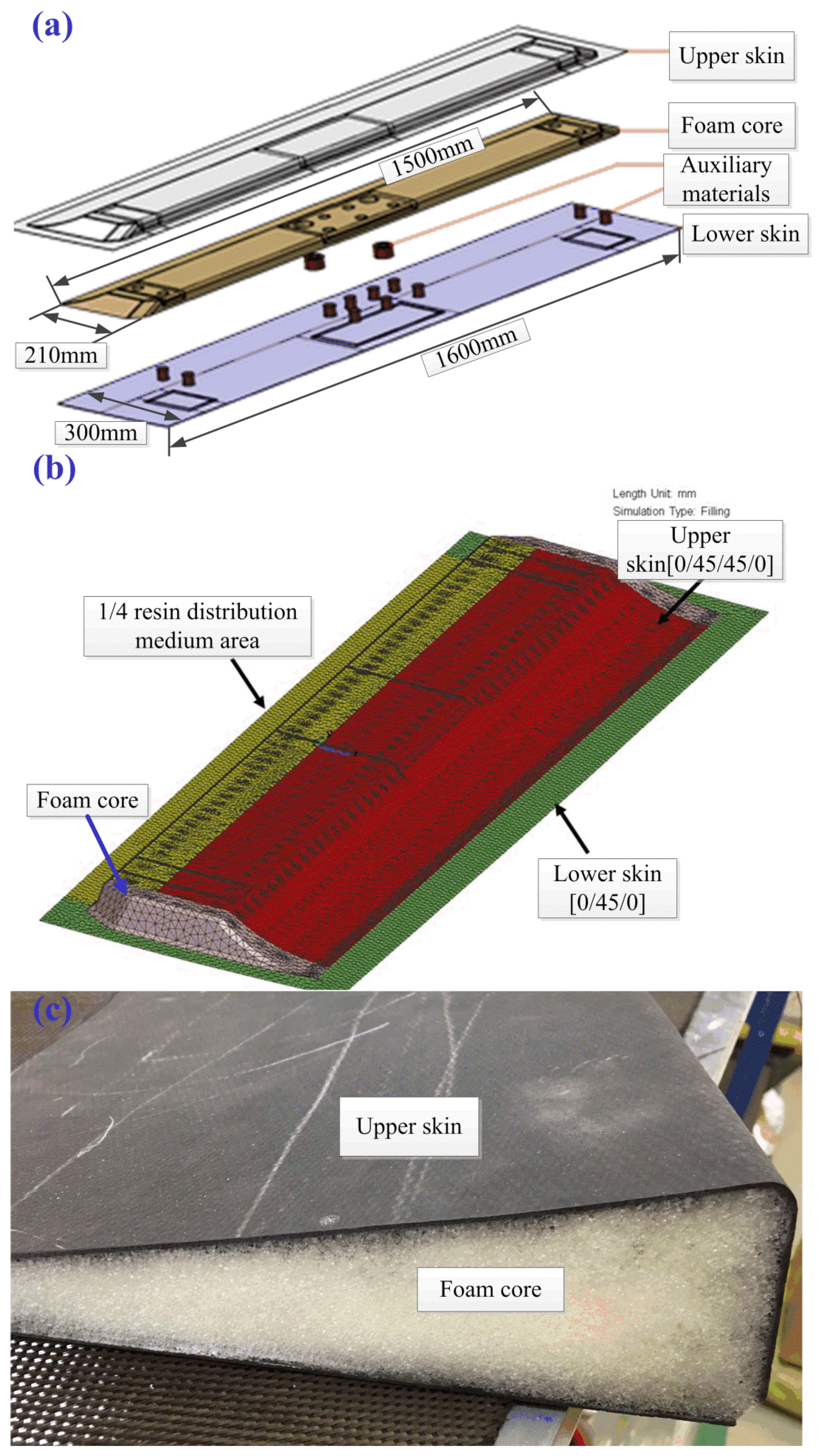
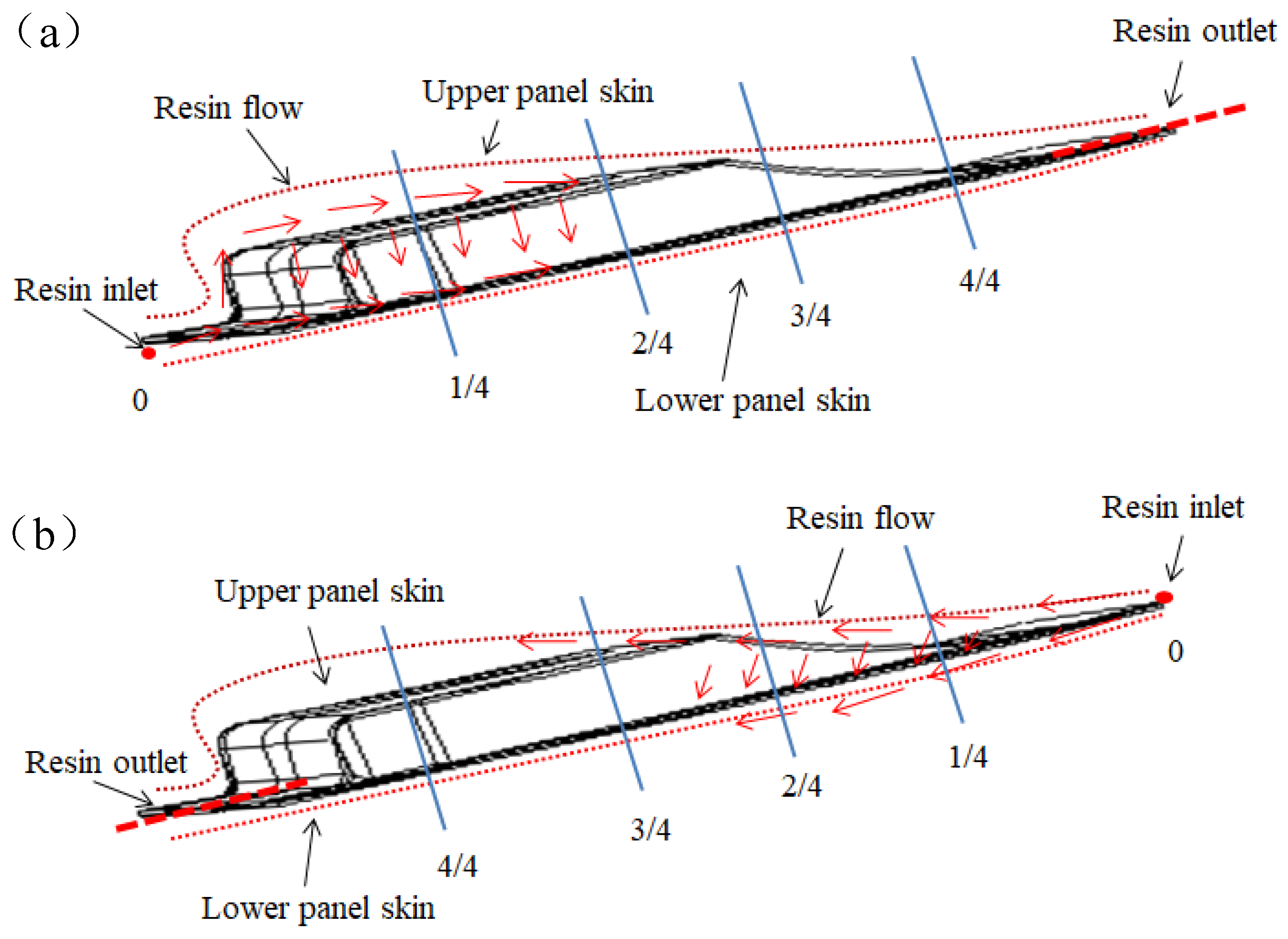

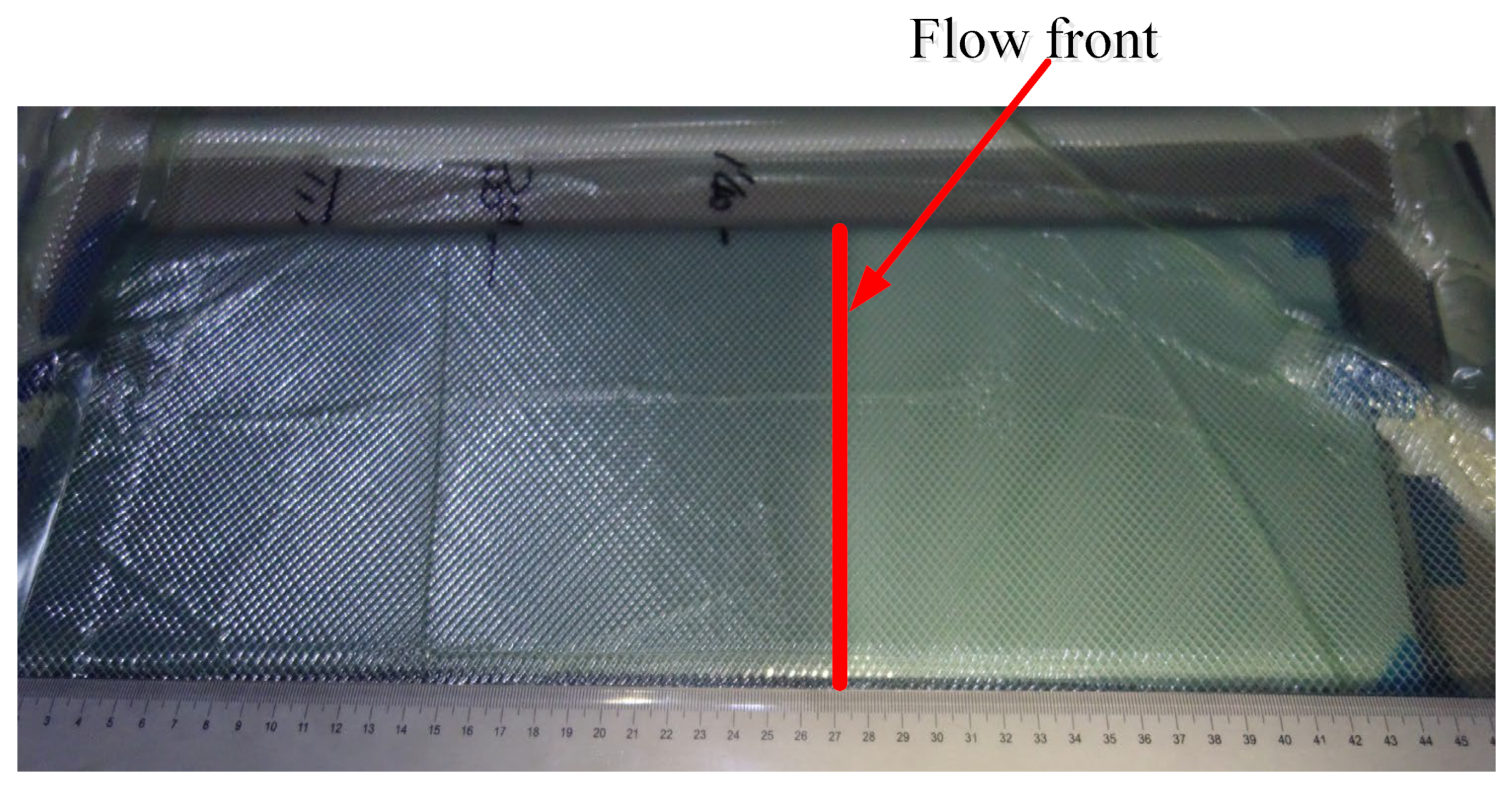
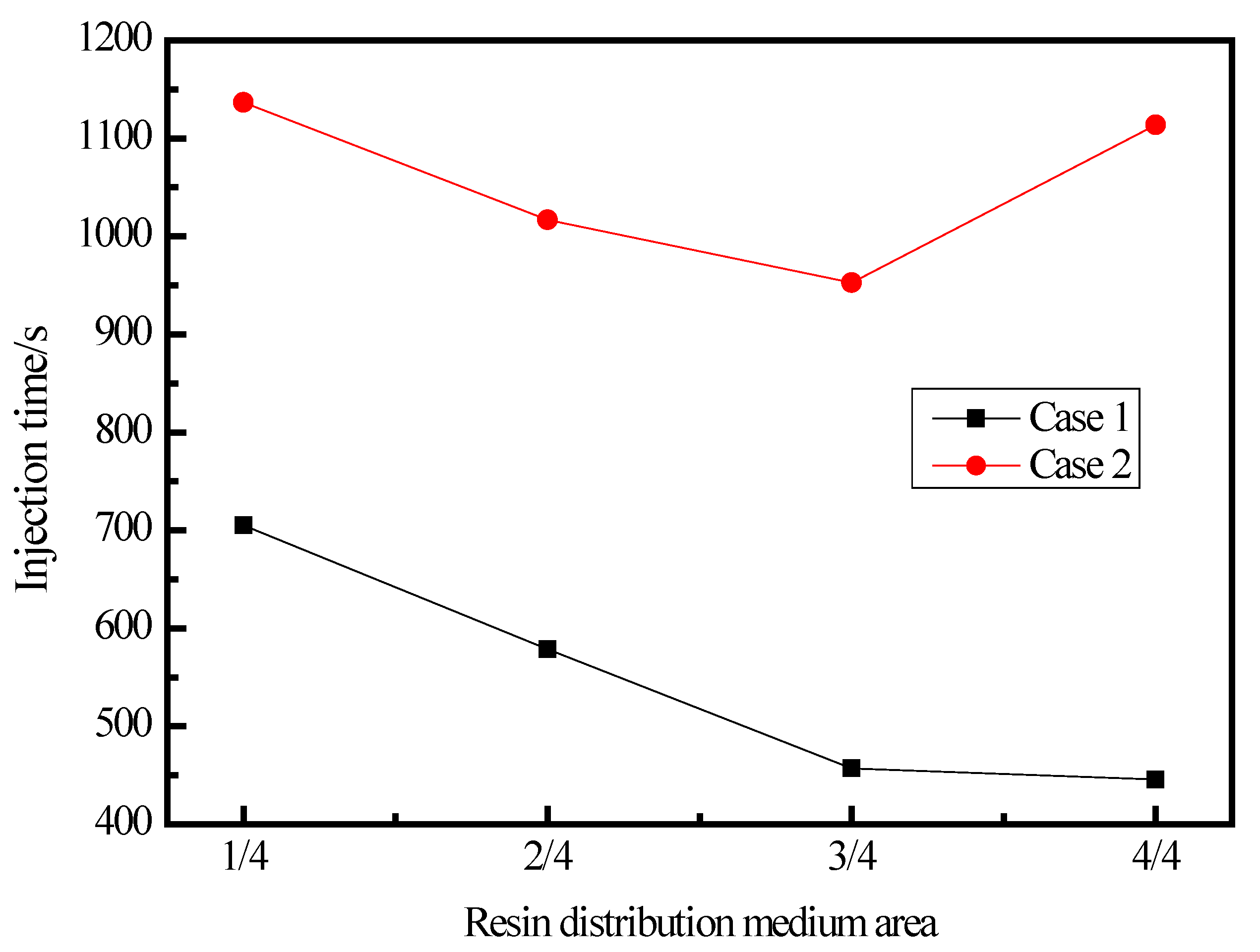
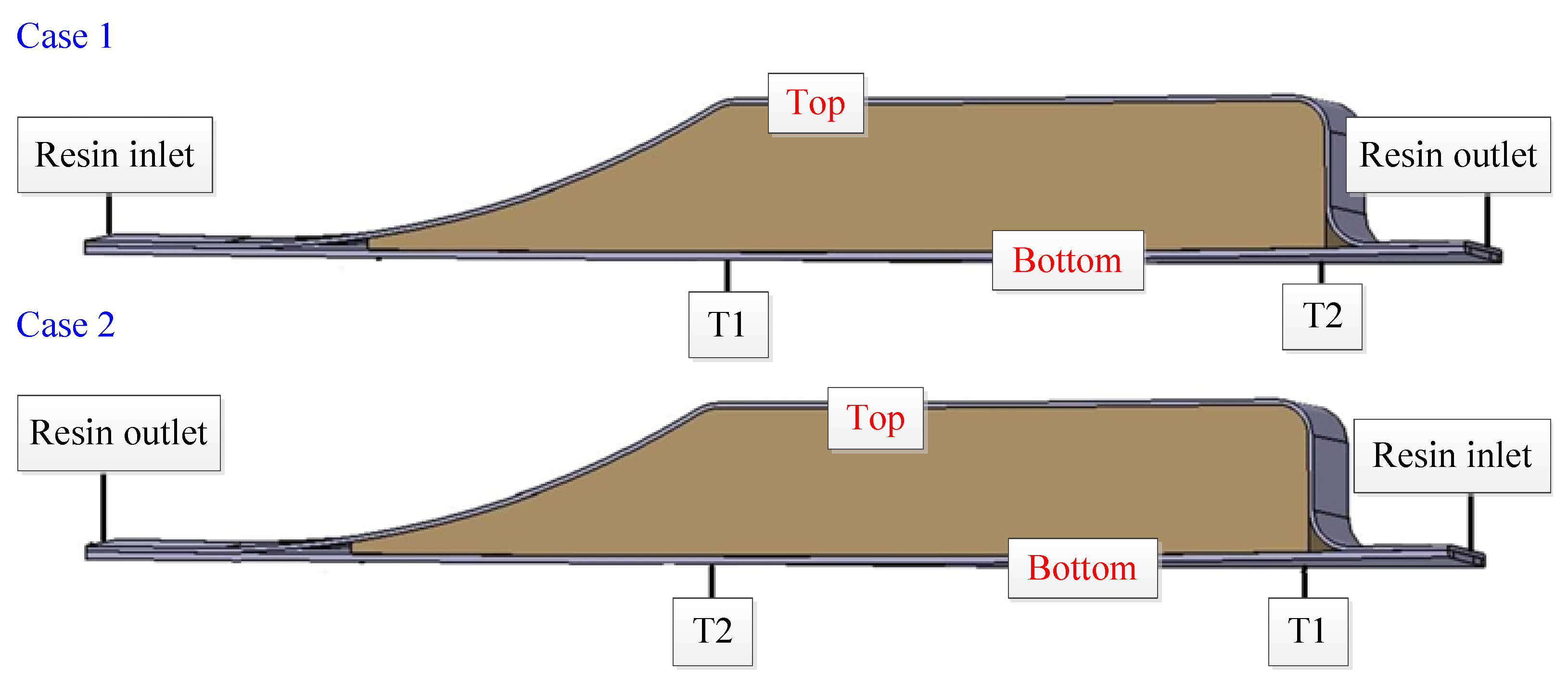



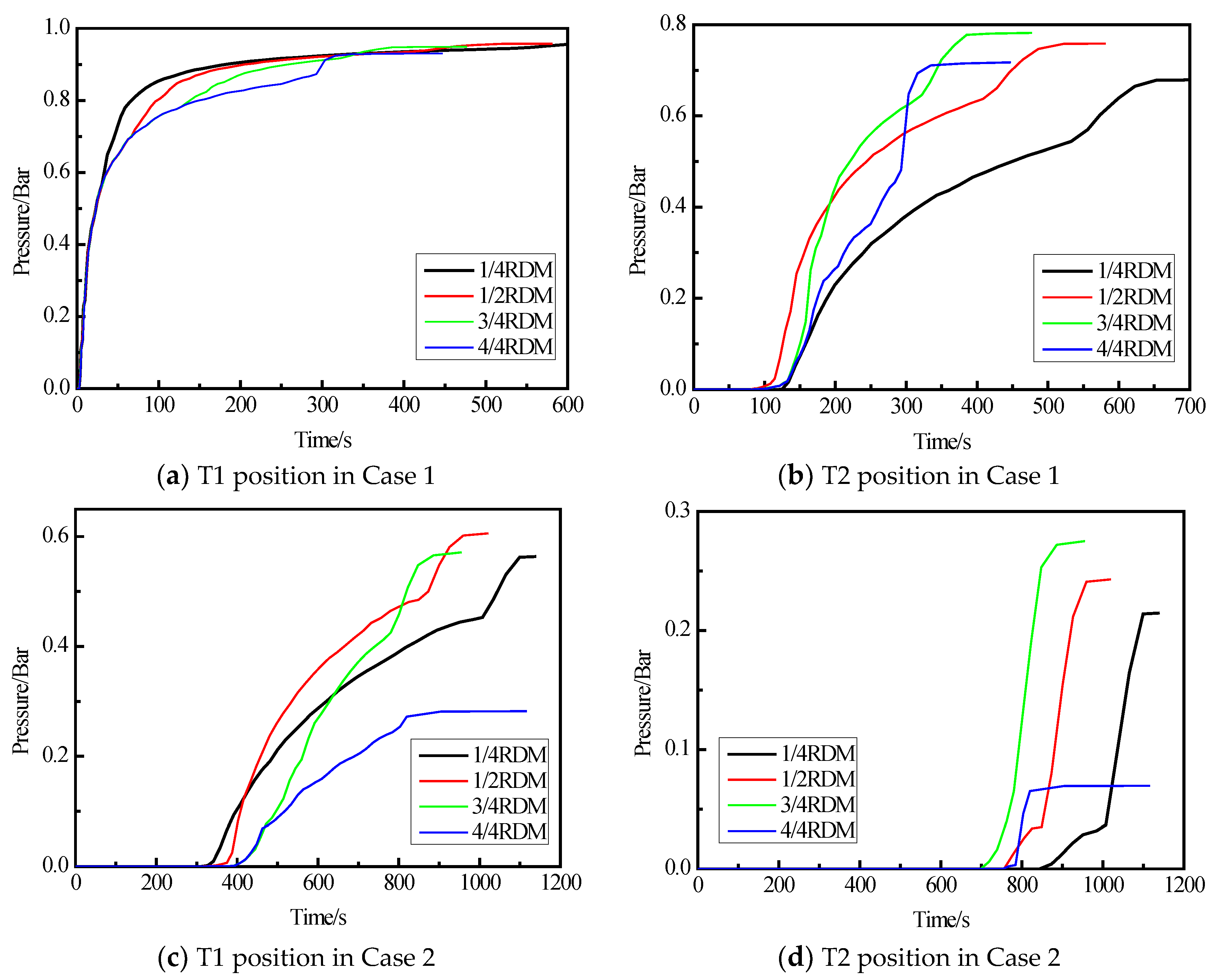
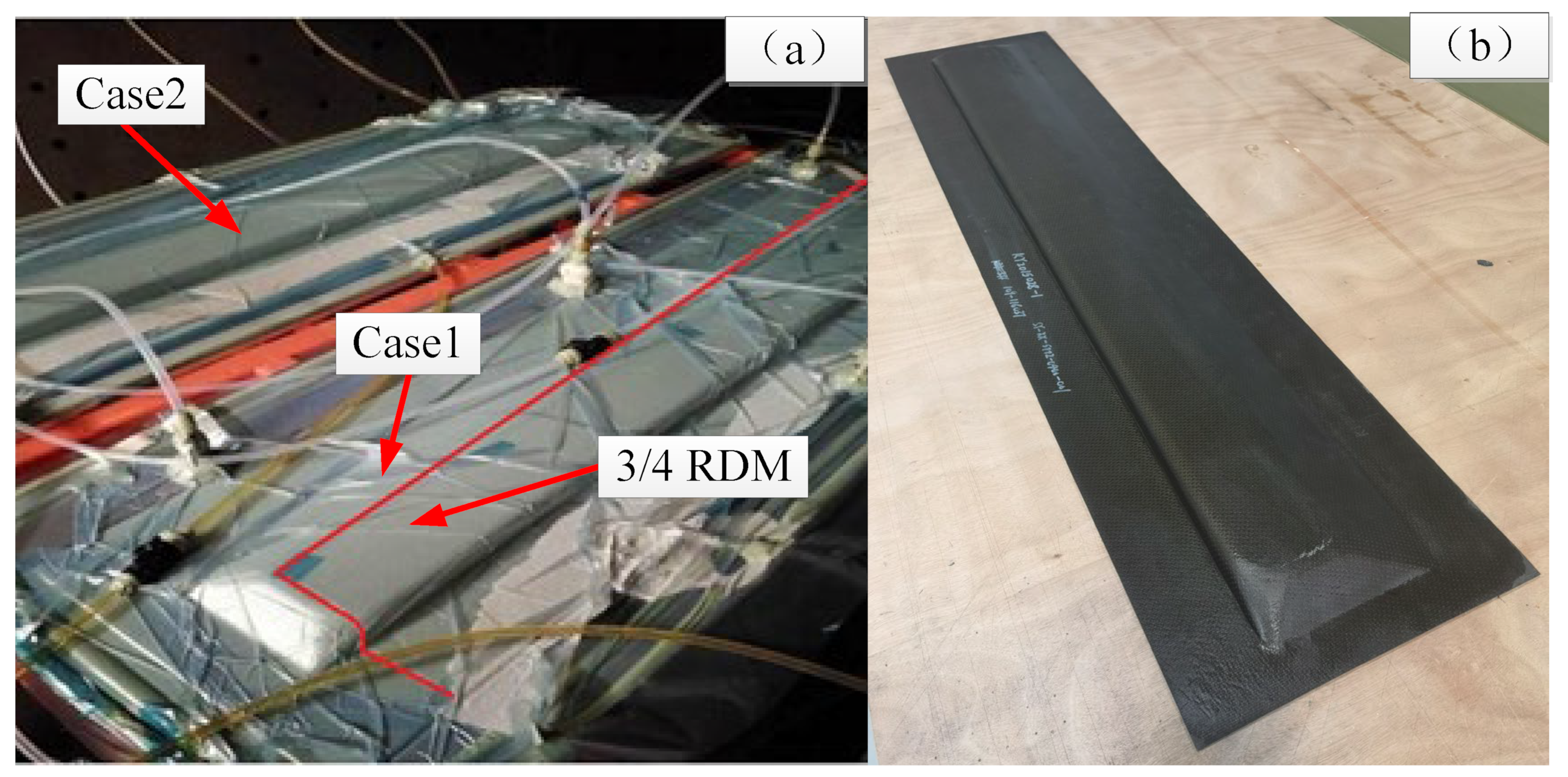
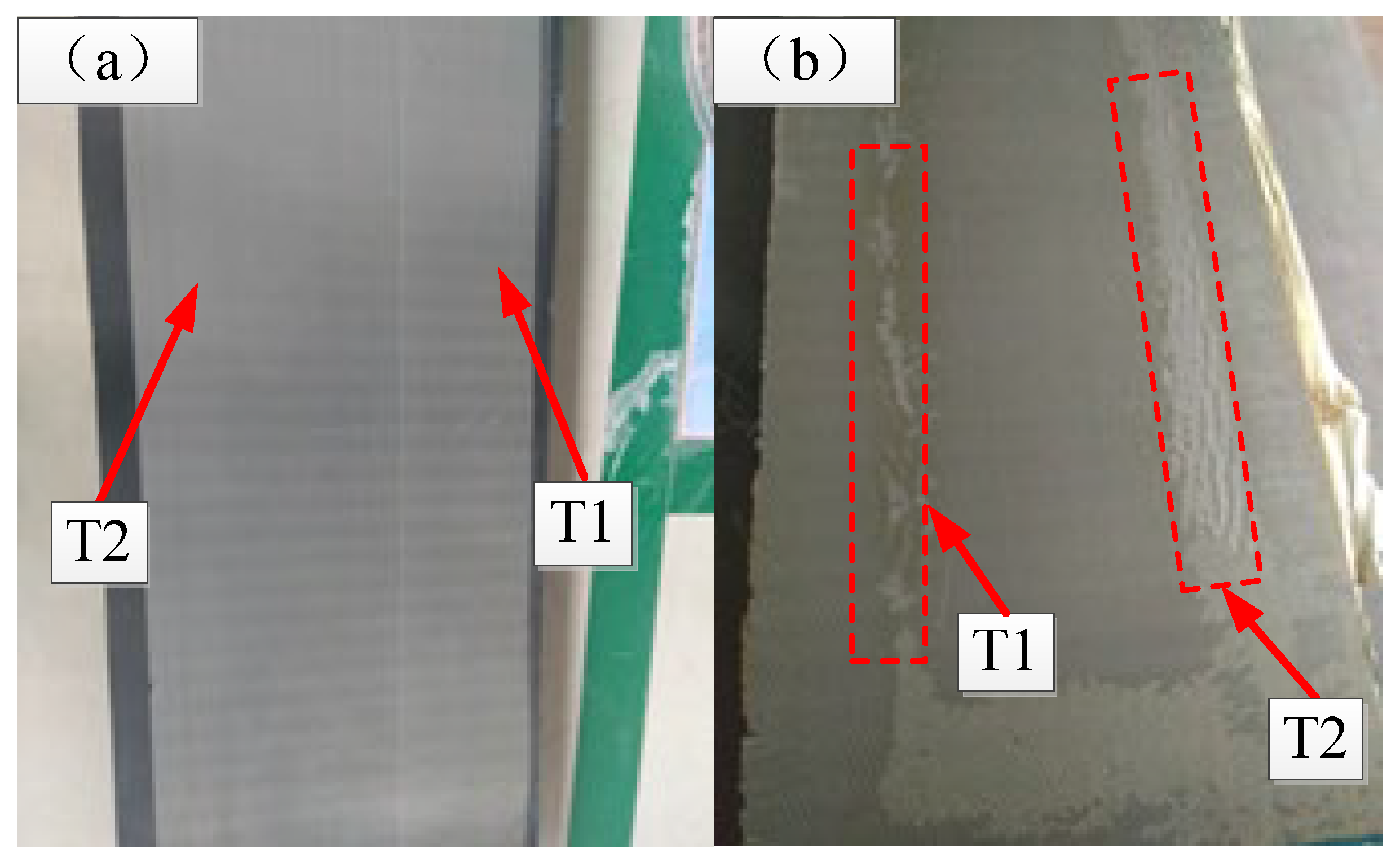
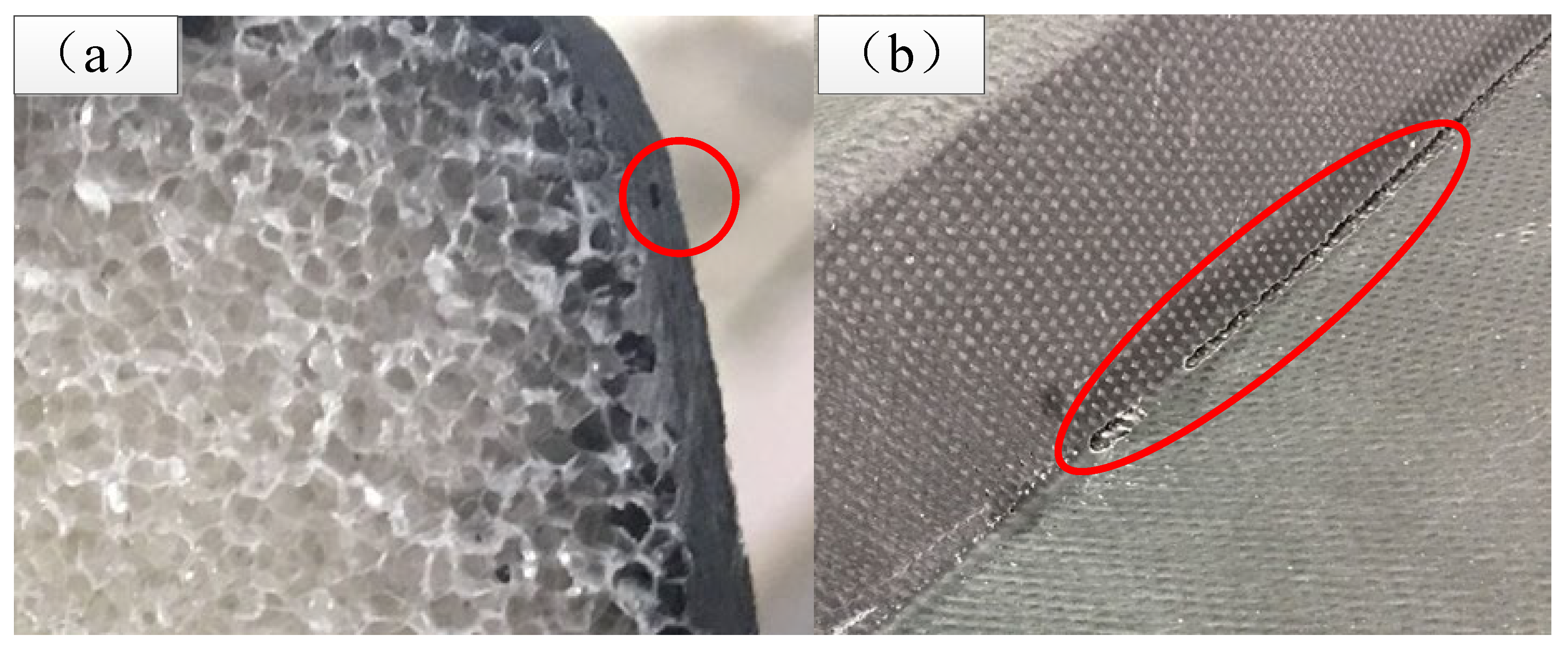

| RDM Area | T1 | T2 | |||||||
|---|---|---|---|---|---|---|---|---|---|
| 1/4 | 2/4 | 3/4 | 4/4 | 1/4 | 2/4 | 3/4 | 4/4 | ||
| Case 1 | Upper skin | 5.1 s | 5.1 s | 5.2 s | 5.7 s | 153 s | 101 s | 91 s | 86 s |
| Lower skin | 5.1 s | 5.1 s | 5.2 s | 5.7 s | 143 s | 121 s | 116 s | 127 s | |
| Time difference | 0 s | 0 s | 0 s | 0 s | 10 s | −20 s | −25 s | −41 s | |
| Case 2 | Upper skin | 296 s | 264 s | 257 s | 256 s | 950 s | 825 s | 739 s | 672 s |
| Lower skin | 341 s | 335 s | 329 s | 329 s | 924 s | 805 s | 763 s | 753 s | |
| Time difference | −45 s | −71 s | −72 s | −73 s | 26 s | 20 s | −24 s | −81 s | |
Publisher’s Note: MDPI stays neutral with regard to jurisdictional claims in published maps and institutional affiliations. |
© 2022 by the authors. Licensee MDPI, Basel, Switzerland. This article is an open access article distributed under the terms and conditions of the Creative Commons Attribution (CC BY) license (https://creativecommons.org/licenses/by/4.0/).
Share and Cite
Yan, C.; Li, Y.; Su, X.; Liu, Q.; Wang, Y.; Wu, K.; Wu, X. Resin Flow Analysis for the Foam Core Sandwich Spoiler by Vacuum-Assisted Resin Injection Process. Materials 2022, 15, 5279. https://doi.org/10.3390/ma15155279
Yan C, Li Y, Su X, Liu Q, Wang Y, Wu K, Wu X. Resin Flow Analysis for the Foam Core Sandwich Spoiler by Vacuum-Assisted Resin Injection Process. Materials. 2022; 15(15):5279. https://doi.org/10.3390/ma15155279
Chicago/Turabian StyleYan, Chao, Yishen Li, Xia Su, Qi Liu, Yuning Wang, Kai Wu, and Xiaoqing Wu. 2022. "Resin Flow Analysis for the Foam Core Sandwich Spoiler by Vacuum-Assisted Resin Injection Process" Materials 15, no. 15: 5279. https://doi.org/10.3390/ma15155279
APA StyleYan, C., Li, Y., Su, X., Liu, Q., Wang, Y., Wu, K., & Wu, X. (2022). Resin Flow Analysis for the Foam Core Sandwich Spoiler by Vacuum-Assisted Resin Injection Process. Materials, 15(15), 5279. https://doi.org/10.3390/ma15155279





